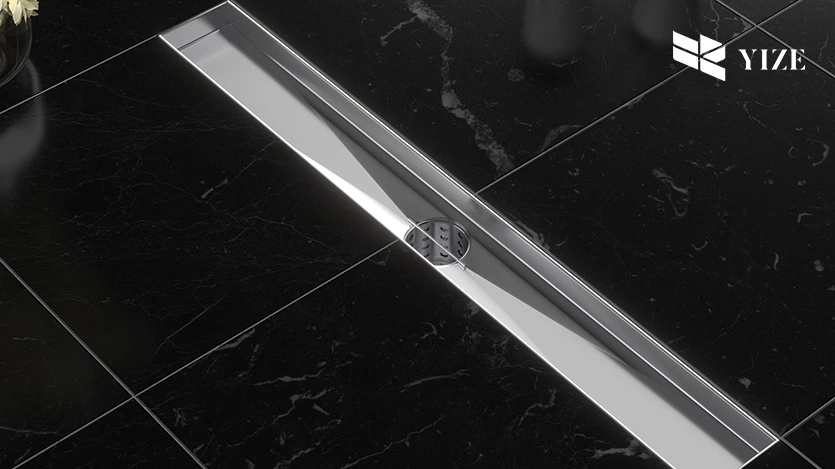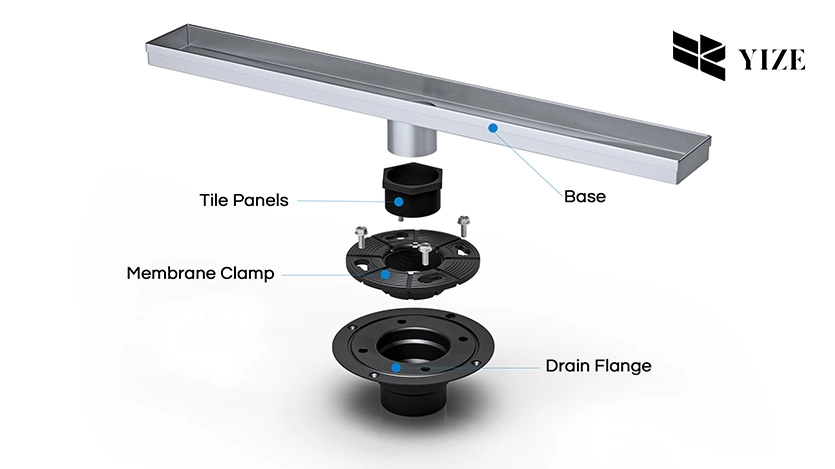
I. Introduction
Choosing the correct size of linear shower drain is very important, but is something that is often overlooked. This article examines typical linear shower drain size and drain-to-shower-pan matching rules as well as addresses topics about flange use and provides answers to common questions.
II. What Size Are Linear Shower Drains?
Linear shower drains are available in dimensions which span from 24 inches up to 72 inches. Your shower flooring layout together with its physical dimensions determines the appropriate linear shower drain size. Here’s a simple breakdown:
| Linear Shower Drain Size | Best for Shower Size | Drainage Capacity |
| 24 inches | Small showers (3ft x 3ft) | Standard drainage |
| 30 inches | Medium showers (3ft x 4ft) | Good flow rate |
| 36 inches | Standard walk-in showers (4ft x 5ft) | High drainage efficiency |
| 48 inches | Large walk-in showers (5ft x 6ft) | Excellent drainage |
| 60+ inches | Extra-large showers or open wet rooms | Maximum water flow |
A rule to live by is that the longer the pipe, the more voluminous the water flow. A drain that runs all the length and width of the shower base properly directs water, letting no water linger on the surface.
III. Linear Drain Shower Pan Sizes

Shower pans are not compatible with all linear drains and the type of pan must be consistent with that of the drain. The shower pan should also be of the same size as the drain used and must also have a desirable slope for the water.
Choosing the Right Shower Pan for Your Drain
- Pre-sloped Shower Pans: There are shower pans that are sloped to a linear drain which makes water flow downwards easily.
- Custom Tiled Pans: The size has to be somewhat working, but the slope should be created with great attention to manage the drainage.
- Several types exist with Fiberglass or Acrylic Pans: Some shower bases may not accommodate linear drains, so consult before buying.
The 36-inch drain is most suitable for a shower pan measuring 4ft x 5ft, and a 48-inch drain suits a 5ft x 6ft pan. The drain length must always be proportional to the width of the shower to ensure the system’s effectiveness.
IV. Does a Flange for a Linear Shower Drain Need to Be Used?

A flange is an imperative yet unnoticed component of a linear shower drain system, which many customers fail to comprehend when installing their shower drains. But do you actually need one?
1. What is a Flange?
It is a plate that assists to ensure no seepage of water through the gap between the floor of the shower and the drain.
2. When is a Flange Necessary?
- If you are installing traditional waterproofing membrane applications.
- The next situation is when your linear drain is located inside the shower pan that has an integrated slope.
- If you intend to reduce the leaks in areas such as hotels, and spas that are changing frequently you need
3. When Can You Skip a Flange?
- If you are using a current type of bonded waterproofing system.
- If you have a linear drain that comes with a bonding flange, it is already bonded to the system (meaning no additional flange is required).
Remember the famous rule, ‘Do not try to be clever and follow the instructions given by the manufacturer’. If a flange is missed where it is required, it will surely cause damage, and it will be expensive to rectify.
V. Conclusion
The size of the linear shower drain is a paramount factor that must be considered especially when it comes to water sucking and the absence of leaking. The drain is supposed to follow the width of your shower, the gradient is supposed to be correctly set, and depending on the situation, there is supposed to be a flange for the waterproofing of the area.
For this kind of showering improvement, choosing an appropriate linear shower drain size will improve the overall efficiency as well as the look of the shower space. Important points to consider are that you should measure carefully, follow proper installation techniques, and maintain the drain properly to avoid any hassle while using the shower.
Frequently Asked Questions (FAQs)
Q1: How do I choose the right size linear shower drain?
To select the linear shower drain size, measure the width of your shower area and buy a drain one size less than the width. When the shower’s width is 48 inches, the recommended size of the drain is 36 inches or 42 inches.
Q2: Can I install a linear shower drain in an existing shower?
However, its design does need certain changes, such as the slope of the shower floor. A linear drain can be easily installed when a full bathroom renovation project is underway.
Q3: How much slope does a linear shower drain need?
The floor should be sloped not less than ¼ inch per every one feet towards the drain if adequate drainage is needed.
Q4: Do linear shower drains clog easily?
Not if they’re maintained properly. Some of the linear drains have strainer that can be removed so as to allow easy cleaning of hair and other debris.
Q5: What is the best material for a linear shower drain?
Stainless steel is the most durable and rust-resistant option. Other materials, like brass or PVC, are available but may not last as long.
Q6: How much does a linear shower drain cost?
Prices vary based on size and brand but expect to pay between $100 and $500 for a quality linear shower drain. Custom designs or premium materials can cost more.
